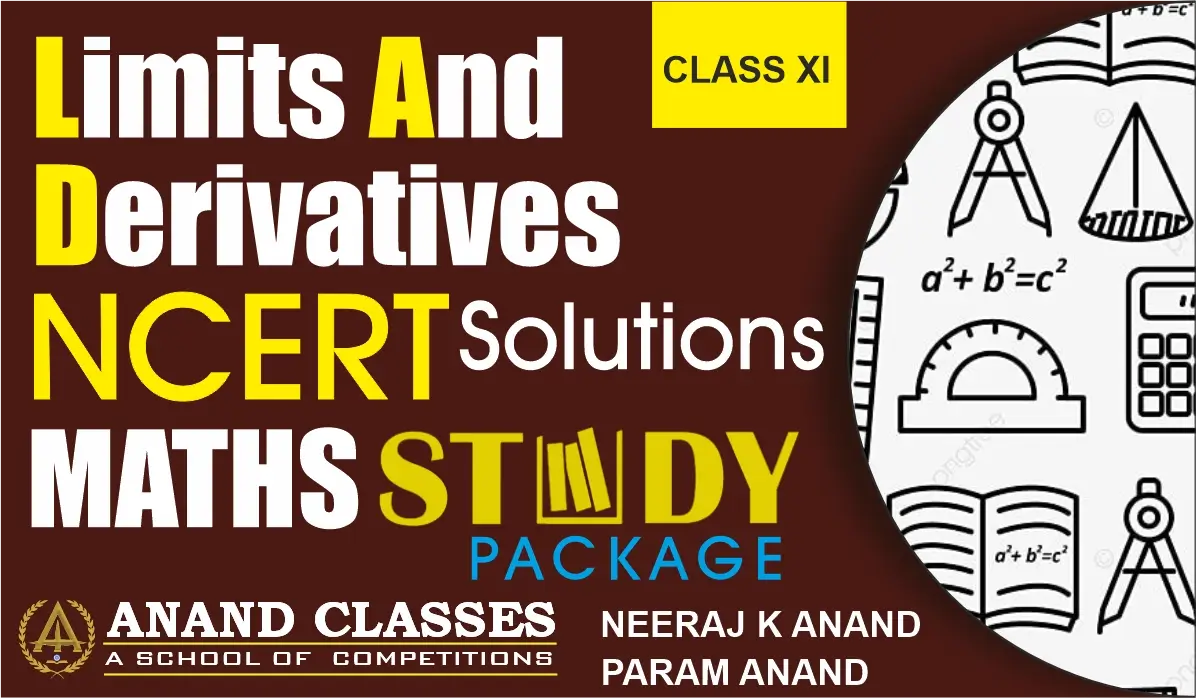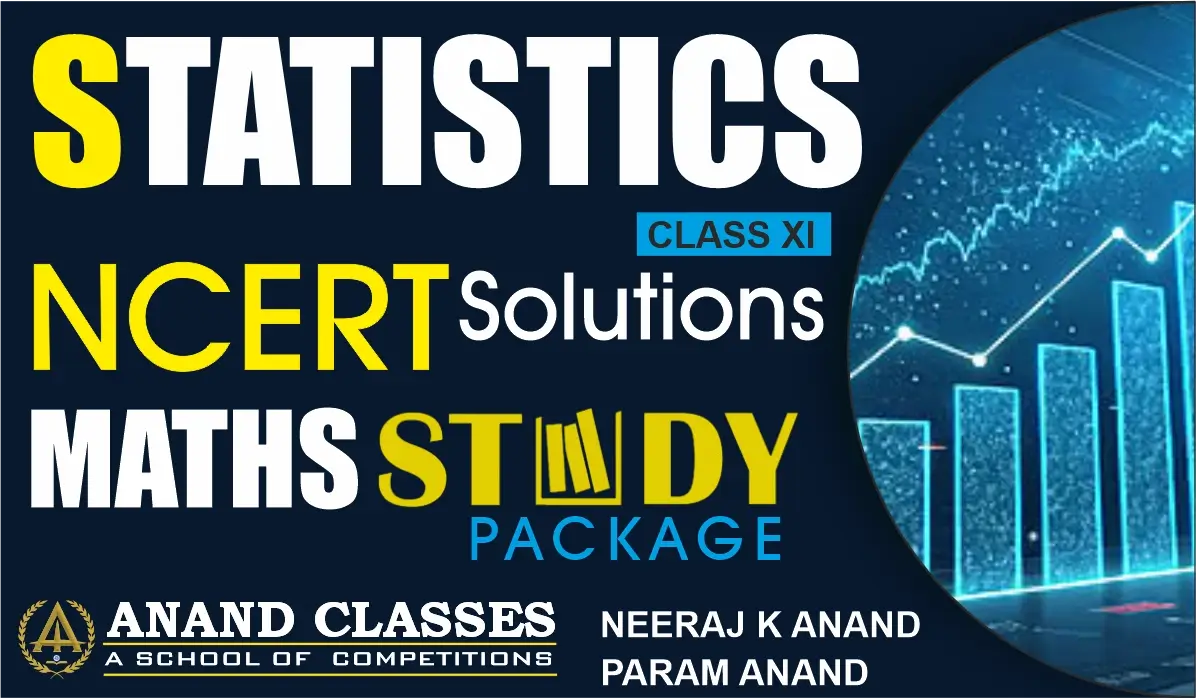Anand Classes provides complete NCERT Solutions for Class 11 Maths Chapter 12 Limits and Derivatives Exercise 12.1, designed to help students understand the fundamental concept of limits in calculus. These step-by-step solutions follow the latest CBSE and NCERT syllabus, ensuring accuracy and conceptual clarity. Each question is solved systematically with proper reasoning and examples to strengthen students’ foundation in calculus and prepare them for higher-level mathematics. Click the print button to download study material and notes.
NCERT Question 1 : Evaluate the limit $$\lim_{x\to 3} (x+3)$$
Solution :
We know that the limit of a polynomial function is the value of the function at the prescribed point. i.e., if $f (x)$ is a polynomial function, then, $\lim_{x\to a} f(x) = f(a)$, obtained by writing $a$ for $x$ in following function
$$\lim_{x\to 3} (x+3)$$
Since the function is continuous, substitute $x=3$:
$$\lim_{x\to 3}(x+3)=3+3=6.$$
NCERT Question.2 : Evaluate the limit $$\lim_{x\to \pi}\left(x-\frac{22}{7}\right)$$
Solution :
Note that π ≠ 22/7 since π is irrational whereas 22/7 is rational. However, 22/7 is an approximate value of π. Hence $\lim_{x\to π} f(x) = f(π)$, obtained by writing $π$ for $x$ in following function
$$\lim_{x\to \pi}\left(x-\frac{22}{7}\right)$$
Substitute $x=\pi$:
$$\lim_{x\to\pi}\left(x-\frac{22}{7}\right)=\pi-\frac{22}{7}.$$
NCERT Question.3 : Evaluate the limit
$$\lim_{r\to 1}\pi r^{2}$$
Solution :
$$\lim_{r\to 1}\pi r^{2}$$
Substitute $r=1$:
$$\lim_{r\to 1}\pi r^{2}=\pi\cdot 1^{2}=\pi.$$
NCERT Question.4 : Evaluate the limit
$$\lim_{x\to 4}\dfrac{4x+3}{x-2}$$
$$\lim_{x\to 4}\dfrac{4x+3}{x-2}$$
Substitute $x=4$:
$$\lim_{x\to4}\dfrac{4x+3}{x-2}=\dfrac{4\cdot4+3}{4-2}=\dfrac{16+3}{2}=\dfrac{19}{2}.$$
NCERT Question.5 : Evaluate the limit
$$\lim_{x\to -1}\frac{x^{10}+x^{5}+1}{x-1}$$
Solution :
$$\lim_{x\to -1}\frac{x^{10}+x^{5}+1}{x-1}$$
Substitute $x=-1$ (numerator and denominator are finite so direct substitution works):
So
$$\lim_{x\to-1}\frac{x^{10}+x^{5}+1}{x-1}=\frac{(-1)^{10}+(-1)^{5}+1}{-1-1}.$$
$$\lim_{x\to-1}\frac{x^{10}+x^{5}+1}{x-1}=\frac{1-1+1}{-1-1}=-\frac{1}{2}.$$
Hence,
$$\lim_{x\to-1}\frac{x^{10}+x^{5}+1}{x-1}=\frac{1}{-2}=-\dfrac{1}{2}.$$
NCERT Question.6 : Evaluate the limit
$$\lim_{x \to 0} \frac{(x + 1)^5 – 1}{x}$$
Solution :
Given limit
$$\lim_{x \to 0} \frac{(x + 1)^5 – 1}{x}$$
On putting $x = 0$, we get
$$\frac{(0 + 1)^5 – 1}{0} = \frac{1 – 1}{0} = \frac{0}{0}$$
which is an indeterminate form.
Let $x + 1 = y$, i.e., $x = y – 1$, so that $y \to 1$ as $x \to 0$.
Then,
$$\lim_{x \to 0} \frac{(x + 1)^5 – 1}{x} = \lim_{y \to 1} \dfrac{y^5 – 1}{y – 1}.$$
Now, we can use the standard theorem
$$\lim_{x\to a}\frac{x^{n}-a^{n}}{x-a}=na^{n-1}$$
to evaluate the limit directly.
Now apply the theorem with $n=5$ and $a=1$:
$$\lim_{y\to1}\frac{y^{5}-1^{5}}{y-1}=5\cdot 1^{4}=5.$$
$$\boxed{5}$$
NCERT Question.7 : Evaluate the limit
$$
\lim_{x\to 2}\frac{3x^{2}-x-10}{x^{2}-4}.
$$
Solution :
Given limit
$$
\lim_{x\to 2}\frac{3x^{2}-x-10}{x^{2}-4}.
$$
Substituting $x=2$ gives the indeterminate form $\dfrac{0}{0}$, so factor numerator and denominator.
Factor the numerator:
$$
3x^{2}-x-10 = 3x^{2}-6x+5x-10 $$ $$ 3x(x-2)+5(x-2)=(x-2)(3x+5).
$$
Factor the denominator:
$$
x^{2}-4=(x-2)(x+2).
$$
So for $x\neq2$,
$$
\frac{3x^{2}-x-10}{x^{2}-4}=\frac{(x-2)(3x+5)}{(x-2)(x+2)}=\frac{3x+5}{x+2}.
$$
Now take the limit by direct substitution:
$$
\lim_{x\to2}\frac{3x+5}{x+2}=\frac{3\cdot 2+5}{2+2}=\frac{6+5}{4}=\frac{11}{4}.
$$
Answer
$$\boxed{\displaystyle \lim_{x\to 2}\frac{3x^{2}-x-10}{x^{2}-4}=\frac{11}{4}}$$
NCERT Question 8: Evaluate
$$
\lim_{x \to 3} \frac{2x^2 – 5x – 3}{x^4 – 81}.
$$
Solution:
Substitute $x = 3$ directly:
$$
\frac{2(3)^2 – 5(3) – 3}{(3)^4 – 81}
= \frac{18 – 15 – 3}{81 – 81}
= \frac{0}{0}.
$$
This is an indeterminate form $\frac{0}{0}$, so we factorize numerator and denominator.
Step 1: Factorize the denominator
$$
x^4 – 81 = (x^2)^2 – 9^2 = (x^2 – 9)(x^2 + 9) = (x – 3)(x + 3)(x^2 + 9).
$$
Step 2: Factorize the numerator
$$
2x^2 – 5x – 3 = 2x^2 – 6x + x – 3 = (2x + 1)(x – 3).
$$
Step 3: Substitute factored forms
$$
\lim_{x \to 3} \frac{(2x + 1)(x – 3)}{(x – 3)(x + 3)(x^2 + 9)}.
$$
Cancel $(x – 3)$ (since $x \ne 3$ in the limit process):
$$
\lim_{x \to 3} \frac{2x + 1}{(x + 3)(x^2 + 9)}.
$$
Step 4: Substitute $x = 3$
$$
= \frac{2(3) + 1}{(3 + 3)\big((3)^2 + 9\big)}
= \frac{7}{6(18)} = \frac{7}{108}.
$$
✅ Final Answer:
$$
\boxed{\displaystyle \lim_{x \to 3} \frac{2x^2 – 5x – 3}{x^4 – 81} = \frac{7}{108}}
$$
This problem demonstrates how factorization removes indeterminate forms in rational functions.
For more such Class 11 Limits and Continuity explanations and JEE Main preparation tips, visit Anand Classes Learning Portal.
NCERT Question 9 : Evaluate:
$$\lim_{x \to 0} \frac{a x + b}{c x + 1}$$
Solution:
As $x \to 0$, substitute $x = 0$ in the expression.
$$\lim_{x \to 0} \frac{a x + b}{c x + 1} = \frac{a(0) + b}{c(0) + 1}$$
Simplifying, we get:
$$\lim_{x \to 0} \frac{a x + b}{c x + 1} = \frac{b}{1} = b$$
✅ Final Answer:
$$\boxed{b}$$
For more detailed explanations on Limits and Continuity, explore step-by-step NCERT and JEE-level math solutions by Anand Classes for strengthening your foundation in calculus concepts.
NCERT Question 10 : Evaluate:
$$\lim_{z \to 1} \frac{z^{\frac{1}{3}} – 1}{z^{\frac{1}{6}} – 1}$$
Solution:
As $z \to 1$, substitute $z = 1$ in the expression:
$$\lim_{z \to 1} \frac{z^{\frac{1}{3}} – 1}{z^{\frac{1}{6}} – 1} = \frac{1^{\frac{1}{3}} – 1}{1^{\frac{1}{6}} – 1} = \frac{0}{0}$$
This is an indeterminate form $\frac{0}{0}$.
Let
$$z^{\frac{1}{6}} = p \implies z = p^6.$$
Then as $z \to 1$, we have $p \to 1$.
Substitute in the limit:
$$\lim_{p \to 1} \frac{(p^6)^{\frac{1}{3}} – 1}{p – 1} = \lim_{p \to 1} \frac{p^2 – 1}{p – 1}.$$
Now, factorise the numerator:
$$p^2 – 1 = (p – 1)(p + 1).$$
So,
$$\lim_{p \to 1} \frac{(p – 1)(p + 1)}{p – 1} = \lim_{p \to 1} (p + 1).$$
Cancelling $(p – 1)$, we get:
$$\lim_{p \to 1} (p + 1) = 1 + 1 = 2.$$
✅ Final Answer:
$$\boxed{2}$$
For more calculus practice problems on Limits, Continuity, and Differentiability, explore detailed step-by-step NCERT and JEE preparation notes by Anand Classes.



